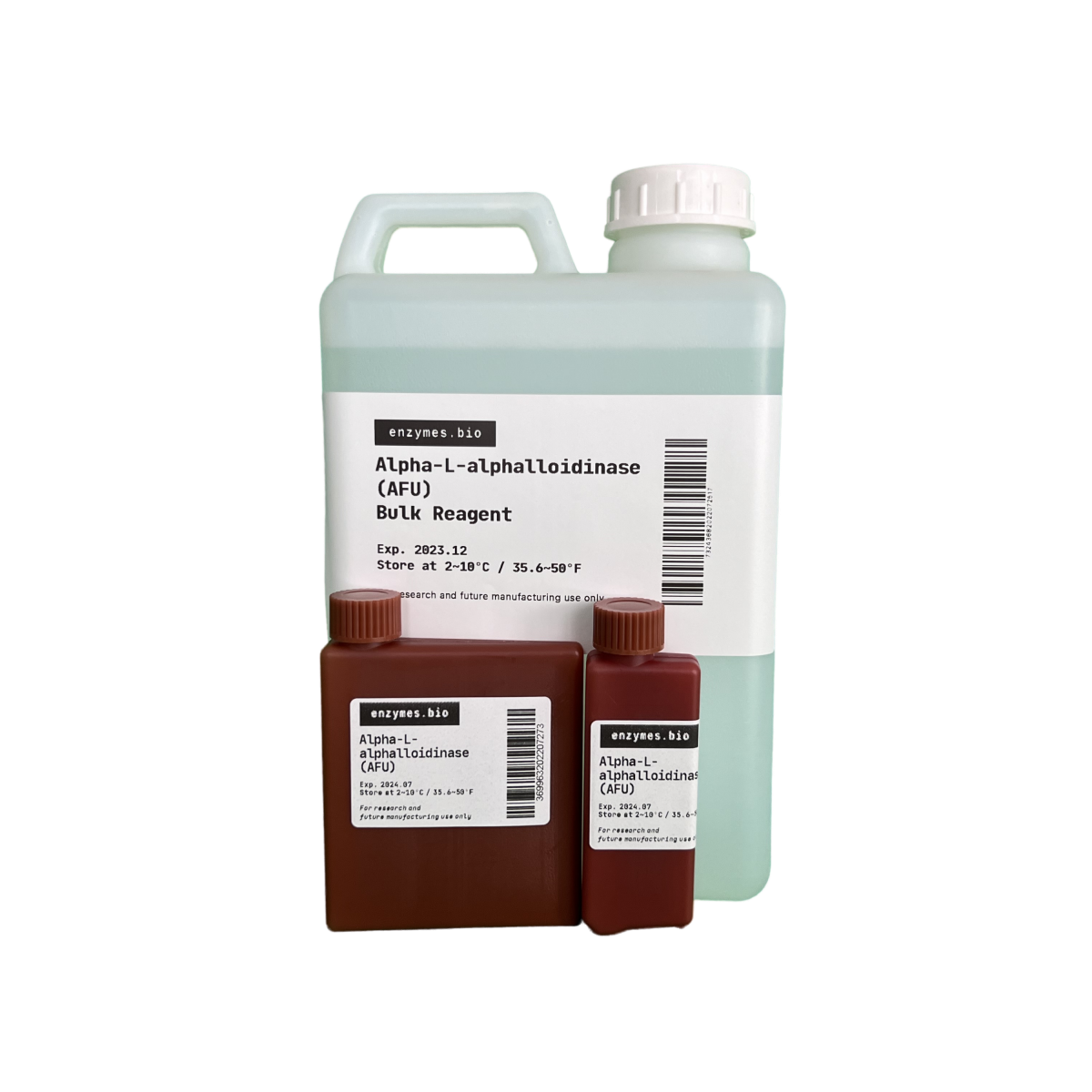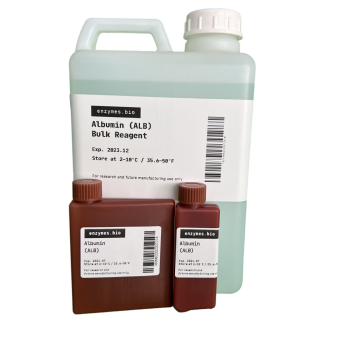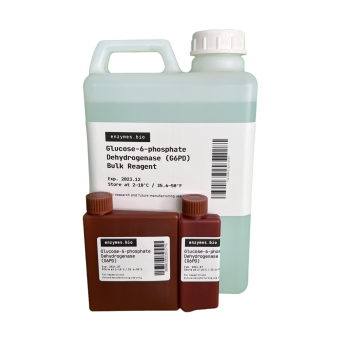Selling unit: per 100ml
Product Name
Common name: α-L-amylase (AFU) assay kit (rate method)
English Name.AFU Reagent Kit (Kinetic Method)
Reagent Ratio
Single, 3:1, 4:1 (common ratio), other ratios need to be customized
Product Use
For the determination of alpha-L-alphalloidinase (AFU) activity in human serum or plasma.
The activity of AFU in serum is an important indicator for the diagnosis of hepatocellular carcinoma, and a high AFU can be used for the early diagnosis of hepatocellular carcinoma. AFU activity can also be elevated in cirrhosis and acute and chronic hepatitis, but to a lesser extent and with a negative correlation with ALT (R=-0.33) for differentiation. In particular, AFU is recommended for the diagnosis of small hepatocellular carcinoma tumors and is particularly significant.
Detection Principle
Under the action of α-L-fucosidase, 2-chloro-4-nitrophenyl-α-L-fucoside (CNPF) was decomposed into 2-chloro-4-nitrophenyl (CNP) and fucose, and the absorbance was measured at 404 (400~420) nm, and the rate of decrease in absorbance was proportional to the AFU activity. By monitoring the rate of decrease in absorbance at 404 (400~420) nm, the activity of AFU in the samples could be calculated.
AFU
CNPF ──→ CNP + fucose
Reagent Composition
Single reagent composition

Dual reagent composition
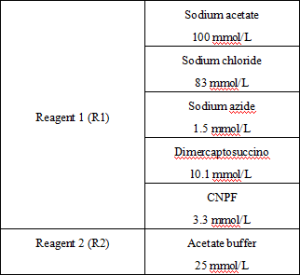
Storage Expiration Date
Unopened kits can be stable for one year when stored at 2-8℃ away from light; reagents can be stable for one month when stored at 2-8℃ away from light after opening the bottle. Reagents should not be frozen.
Sample Request
Samples are fasting serum and plasma (EDTA anticoagulation, 1.8 mg EDTA can resist 1.0 ml of blood, heparin and sodium citrate anticoagulated plasma are prohibited). Samples should be transported and stored under low temperature conditions. AFU in samples is stable for 3 days at 2-8°C and for 1 month when stored on ice.
Measurement Method
Test conditions: (different parameters on the machine can be requested according to different testing instruments)
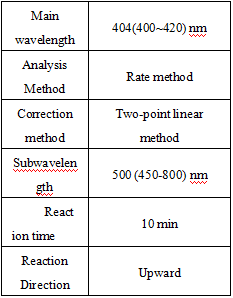
Operation steps.
Single reagent operation: liquid single reagent, can be used directly.
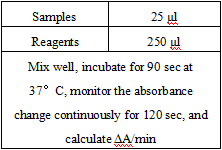
Dual reagent operation: both reagent 1 and reagent 2 are liquid products and can be used directly.
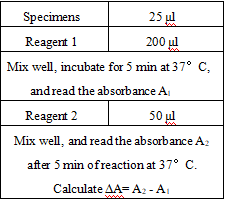
Reagents and sample volumes can be increased or decreased in proportion to the requirements of different biochemical analyzers.
Calculation.
AFU activity (U/L) in the sample = (ΔA样品 /min-ΔA空白 /min) × Vt × 1000/(e × Vs × L) = ΔA /min × K = ΔA /min × 1375
Eq.
1375 The theoretical K value of this standard measurement condition at a wavelength of 404 nm and an optical diameter of the colorimetric cup of 1 cm
Vt Total reaction volume (ml)
Vs Sample volume(ml)
e The millimolar extinction coefficient of 2-chloro-4-nitrobenzene (CNP) at 404 nm was 8
L Light diameter of colorimeter(cm)
ΔA样品 /min Average change in absorbance per minute of sample tube
ΔA空白 /min Average absorbance change per minute of blank tube
It is recommended that each laboratory establish its own quality control system and select appropriate quality control products for quality control. The measured values of QC products should be within the specified range. If outside the specified range, it is necessary to take appropriate measures or contact the manufacturer.
Reference Range
0~40 U/L
It is recommended that each laboratory establish its own reference range of normal values.
Anti-interference
Ascorbic acid ≤ 5 mg/dl (284 µmol/L), bilirubin ≤ 40 mg/dl (684 µmol/L), hemoglobin ≤ 200 mg/dl (2 g/L), and internal lipids ≤ 1.5 % (equivalent to celiac particles ≤ 1500 mg/dl (15 g/L)) did not interfere with the assay.
Performance Indicators
Absorbance of reagent blank: wavelength 404 nm, optical diameter 1.0 cm, temperature 37°C± 1°C, A0 ≤ 0.2. A0 > 0.2 when disabled or replaced with new reagent.
Reagent blank absorbance change rate: wavelength 404 nm, optical diameter 1.0 cm, temperature 37 ℃± 1 ℃, the measured reagent absorbance change value ︱ △A/min ︱ ≤ 0.01.
Analytical sensitivity: The minimum detection limit of the reagent is 5 U/L.
Linearity range: 5~150 U/L (Judgment basis: r ≥ 0.975). If out of linear range, please measure after dilution with saline and multiply the result by the dilution factor.
Precision: intra-batch coefficient of variation ≤ 5.0 %; inter-batch coefficient of variation ≤ 6.0 %.
Accuracy: Absolute value of relative deviation ≤ 10 %.
Correlation: Comparison with similar products: n = 120, r = 0.9926, y = 0.9836x + 1.2035 (y: our reagent; x: other reagents)
Caution
- 1. This product is for in vitro diagnosis only, please use it correctly according to the instruction manual.
2、When using the reagent, avoid contamination, the container used must be clean, and please take necessary precautions, do not swallow, and avoid contact with skin and mucous membrane.
3、Please dispose of the measured samples and waste liquid in accordance with the relevant national and local laws and regulations.
- 4. Do not exchange reagents with different batch numbers.
5、Please re-calibrate when changing the reagent lot number.
- 6. Theoretical K values are for reference only and may not be the same as the actual K values, so it is recommended to use calibrated serum to set the standard.
Reference
- SCHETTLER G., NUSSEL E., ARBEITSMED. sozialmed. praventivmed (1975); 10: 25
